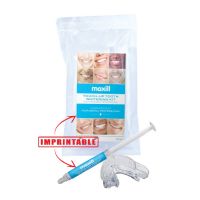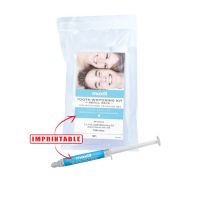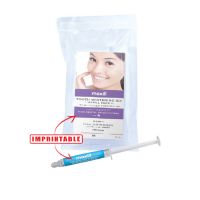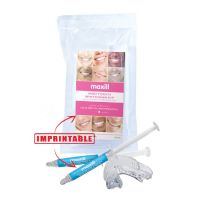The Science Behind Dental Tooth Whitening

Dental tooth whitening has surged in popularity, thanks partly to the influence of social media and selfie culture. A bright, white smile is often seen as a symbol of good dental hygiene and overall attractiveness. This article delves into the science behind dental tooth whitening, exploring the various methods and mechanisms involved.
Types of Tooth Discoloration
Before exploring the science of tooth whitening, we must understand that tooth discoloration is common. Discoloration refers to any change in the color or transparency of a tooth. There are two main categories of tooth discoloration: extrinsic and intrinsic, or a combination of both. Extrinsic stains are surface stains that occur on the outer layer of the tooth enamel and are often caused by factors such as smoking, coffee, tea, and red wine consumption. Reducing the consumption of these items can help minimize these stains. Extrinsic stains that persist can be removed during prophylaxis using abrasive polishing paste or cleansers in whitening toothpaste formulations.
Intrinsic stains, on the other hand, are stains that occur within the tooth structure (enamel or dentin) and can be caused by factors such as genetics, aging, and medication use. These stains can also develop during the tooth's formation or after eruption, such as from high fluoride concentrations causing fluorosis. Aging can cause changes in tooth coloration due to the thinning of the enamel, which allows the darker dentin layer to show through. Other intrinsic staining can occur from amalgam restorations, discoloration from tetracycline use during tooth development, or traumatic pulpal injury.
The Science behind Tooth Whitening
Tooth whitening of intrinsic stains involves chemically breaking down the molecules that cause tooth discoloration, resulting in a brighter, whiter smile. The most common active ingredients in tooth-whitening products are hydrogen peroxide and carbamide peroxide. These ingredients are used at different concentrations to penetrate the enamel and dentin of the tooth, where they react with the discolored molecules, breaking them down into smaller, less visible particles. The bleaching action in chemically induced whitening is due primarily to the effects of carbamide peroxide, which releases about one-third of its content as hydrogen peroxide, a potent oxidizing agent. Hydrogen peroxide diffuses readily through interprismatic spaces in the enamel, allowing passage from enamel and dentin to pulp within fifteen minutes of exposure. The bleaching process is generally believed to occur when reactive oxygen molecules (generated from hydrogen peroxide) interact with organic chromophores (colored compounds) within enamel and dentin to lighten the color through a chemical oxidation process, which is dependent on various environmental factors (e.g., exposure time, concentration of whitening product, pH, temperature, light). Depending on the various environmental factors, the result is usually one to two shades lighter for over-the-counter polishes and bleach systems and more for in-office professional bleaching procedures.
Tooth Whitening Systems
Several tooth-whitening methods are available, including whitening toothpaste and rinses, in-office bleaching, at-home bleaching kits, and over-the-counter whitening products. The American Academy of Cosmetic Dentistry recognizes the following tooth-whitening methods.
In-Office Bleaching
In-office bleaching involves the application of a high-concentration whitening gel by a dental professional, resulting in quick and effective results. Due to the high agent concentration, gingival tissues must be protected by a blocking product before the bleaching agent can be applied. Some of the products claim to increase the oxidation of chromogens by exposure to heat or light to activate the product and cause the chemical reaction to proceed faster. The lightening effect can be seen after one 30-minute to 60-minute treatment.
At-Home Bleaching
At-home bleaching kits typically use lower concentrations of whitening agents and may require longer treatment times for noticeable results. The process includes using a fitted tray containing carbamide peroxide worn for two to four hours daily or overnight. The whitening effect can be noticed in a few days.
Over-The-Counter Whitening Strips
OTC whitening strips use a layer of hydrogen peroxide on plastic strips and are applied to the facial surfaces of teeth for 30 minutes per day for two weeks. The gel systems use a brush-on application twice daily for two weeks. Some of these systems use a higher concentration of bleaching agent, reducing exposure time.
Whitening Toothpaste
Whitening toothpaste typically contains higher amounts of abrasives and detergents than standard toothpaste to remove tougher stains. The pastes may also contain low concentrations of carbamide or hydrogen peroxide.
Whitening Rinses
Whitening rinses contain oxidizing ingredients such as hydrogen peroxide to react with the stain-producing chromogens. Directions for use include rinsing twice a day for 60 seconds for up to three months to see an improvement in tooth color.
As with all systems, the effect of the whitening result is dependent on the type of intrinsic stain. For example, some brown and yellow stains from aging, fluorosis, and tetracycline may react faster or more effectively than teeth with white stains due to orthodontic treatment or enamel hypoplasia.
Safety Considerations
While tooth whitening is generally considered safe, some potential side effects include increased tooth sensitivity and mild gingival irritation. The level of sensitivity or irritation is correlated to the concentration of active bleaching ingredients, reactions to additional ingredients in the whitening product, and the duration of the treatment. Tooth sensitivity can occur in up to two-thirds of people during the early stages of treatment. Most adverse effects are mild to moderate and usually resolved after treatment. Treatment of tooth sensitivity can be reduced by using fluoride gels or sensitivity toothpaste containing potassium nitrate. Gingival irritation occurs most often due to the exposure of the gingival tissue to the peroxide/carbamide peroxide. It can be avoided by ensuring that the bleaching tray is well fitting as well as proper application of a protective barrier during in-office treatment.
Safety Considerations for Children and Pregnancy Women
The American Academy of Pediatric Dentistry “ discourages full-arch cosmetic bleaching for patients in the mixed dentition, primary dentition, or the use of these products during pregnancy.”
Conclusion
When used following the manufacturer’s instructions, hydrogen peroxide and carbamide peroxide-based tooth whitening are safe and effective. However, as with all dental treatments and procedures, there are risks, and practices should be tailored to the needs of each individual patient based on the type and extent of staining, dietary habits, previous restorations, and other intraoral conditions. Patients should be informed of the risks associated with tooth whitening and, if using agents at home, instructed to identify adverse occurrences and seek professional help if needed. Supervising the tooth whitening process by an oral healthcare professional will reduce the potential risks and optimize the benefits of tooth bleaching.
Thanks for reading our latest blog! If you've got a topic that you'd like to see us tackle next, please submit your suggestion to our blog writing team of dental professionals at blogs@maxill.com.
References:
American Academy of Pediatric Dentistry. Policy on the use of dental bleaching for child and adolescent patients. The Reference Manual of Pediatric Dentistry. Chicago, Ill.: American Academy of Pediatric Dentistry; 2023:128-32.
Carey C. M. (2014). Tooth whitening: what we now know. The Journal of Evidence-based Dental Practice, 14 Suppl, 70–76. https://doi.org/10.1016/j.jebdp.2014.02.006
Whitening. American Dental Association. (n.d.). https://www.ada.org/en/resources/ada-library/oral-health-topics/whitening












